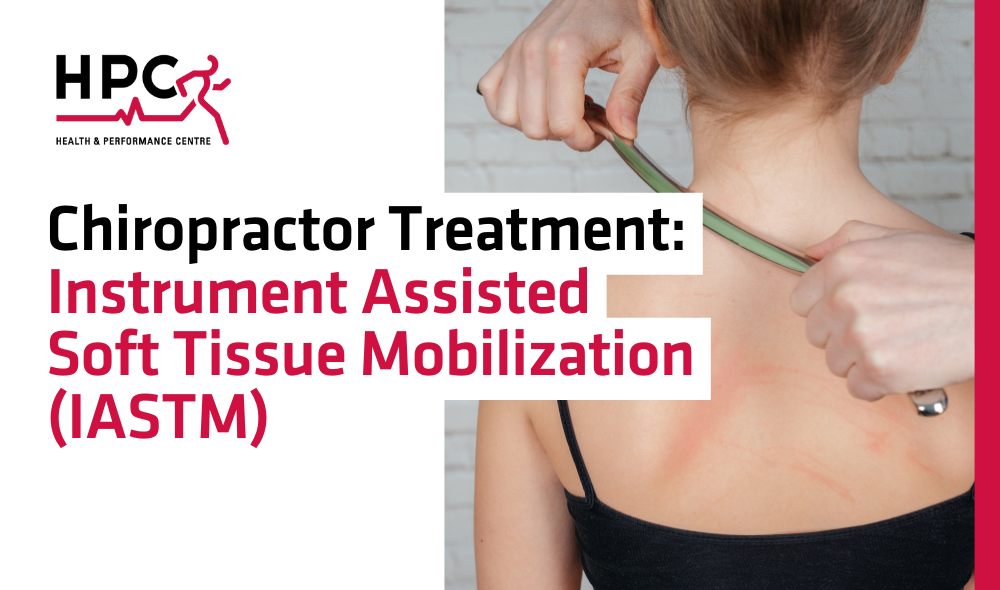Discover the Benefits of IASTM Tools for Soft Tissue Dysfunctions | Chiropractic
Chiropractic care is about more than just being adjusted and that familiar "cracking: sound. While adjustments are a fundamental aspect of chiropractic treatment, chiropractic care encompasses much more than that. Often, your chiropractor will also treat an injury through myofascial release, acupuncture, and a technique called Instrument Assisted Soft Tissue Mobilization (IASTM), which we'll focus on in this article. IASTM is often used as a complementary therapy alongside other treatment modalities such as exercise, stretching, and manual therapy techniques. It can be beneficial for various musculoskeletal conditions, including tendinopathies, myofascial pain syndrome, joint dysfunction, and post-surgical rehabilitation.
Book an Appointment
Learn How HPC Can Help
What is Instrument Assisted Soft Tissue Mobilization (IASTM)?
Instrument Assisted Soft Tissue Mobilization (IASTM) is a specialized manual therapy technique that involves the use of handheld instruments to diagnose and treat soft tissue dysfunctions. It is a non-invasive procedure that aims to improve musculoskeletal function, reduce pain, and enhance the body's natural healing processes.
During an IASTM session, a trained healthcare professional, such as a chiropractor, physical therapist, or athletic trainer, uses ergonomically designed instruments; these are made of various materials, such as stainless steel or plastic.. These instruments have smooth edges and come in different shapes and sizes to accommodate different areas of the body.
The practitioner applies gentle pressure to the affected area while gliding the instrument over the skin. The unique design of the instrument allows for precise targeting of specific tissues, including muscles, tendons, ligaments, and fascia. By applying controlled, repetitive strokes, the practitioner can detect and treat areas of soft tissue dysfunction.
How Does IASTM Work?
The primary goals of IASTM include:
- Stimulating tissue healing and regeneration: IASTM promotes the body's natural healing processes by increasing blood flow to the treated area. This increased blood flow delivers oxygen, nutrients, and immune cells to the tissues, accelerating the healing process and reducing inflammation.
- Improving tissue extensibility and flexibility: IASTM helps to restore proper tissue extensibility and flexibility by breaking up collagen cross-links and reducing tissue adhesions. This can improve range of motion, enhance joint function, and alleviate pain associated with restricted movement.
- Modulating pain perception: The application of IASTM can stimulate sensory nerve receptors in the skin and underlying tissues. This stimulation can help modulate pain signals, providing temporary pain relief and promoting a sense of relaxation.
- Breaking down scar tissue and adhesions: Scar tissue and adhesions can develop in soft tissues as a result of injury, surgery, or chronic overuse. These can restrict mobility, impede circulation, and cause pain. IASTM helps to break down and remodel scar tissue, allowing for improved tissue mobility and function.
Does IASTM Hurt?
The level of discomfort experienced during Instrument Assisted Soft Tissue Mobilization (IASTM) can vary depending on individual sensitivity and the specific areas being treated. However, it's important to note that IASTM is typically designed to be a relatively comfortable procedure.
During the treatment, your HPC chiropractor (or another practitioner) applies controlled pressure to the affected area using the instrument, and the pressure is gradually increased as needed. The goal is to detect and address soft tissue dysfunction without causing excessive pain or discomfort. The instruments used in IASTM are designed with smooth edges to minimize any potential discomfort during the treatment.
While some individuals may experience mild, temporary discomfort or a sensation similar to deep tissue massage during the procedure, it should not be excessively painful. Communicating with your healthcare professional during the session and providing feedback on your comfort level is crucial. They can adjust the pressure and technique to ensure comfort and safety.
It's also important to remember that any discomfort experienced during the treatment is typically temporary and may be followed by a sense of relief and improved mobility as the tissues respond to the therapy.
If you have concerns about pain or discomfort during an IASTM session, discussing them with your HPC chiropractor healthcare professional beforehand is recommended. They can provide further information, address your specific needs, and ensure you are comfortable throughout the treatment.
What Can I Expect From IASTM?
Each individual treatment plan is tailored to each patient, however, you may typically receive 1-2 treatments per week for 4 to 5 weeks. Most patients have a positive response by the 3rd or 4th treatment. Most patients are able to continue to perform their regular activities at home, work or sport.
Is IASTM For You?
IASTM is suitable for anyone who is experiencing common problems such as:
- headaches
- back pain
- carpal tunnel syndrome
- shin splints
- shoulder pain
- sciatica
- foot pain/ plantar fasciitis
- knee problems
- tennis elbow and many other soft tissue injuries
IASTM can be helpful for the following groups of people:
- Athletes and Active Individuals: IASTM is often used in during chiropractic appointments and in sports medicine to address soft tissue injuries, improve recovery, and enhance athletic performance. It can help manage conditions such as muscle strains, ligament sprains, tendinopathies, and overuse injuries commonly seen in athletes and physically active individuals.
- Individuals with Chronic Pain: People suffering from chronic pain conditions, such as myofascial pain syndrome or fibromyalgia, may find relief through IASTM. It can help reduce pain, improve tissue mobility, and enhance overall function, providing a non-invasive treatment option for long-term pain management.
- Rehabilitation and Post-surgical Patients: IASTM is frequently incorporated into rehabilitation programs to aid in the recovery process. It can be beneficial for individuals recovering from orthopedic surgeries, such as joint replacements or ligament repairs; it does so by reducing scar tissue formation, enhancing tissue healing, and improving range of motion.
- Office Workers and Sedentary Individuals: Prolonged sitting and poor posture can contribute to muscle imbalances, restricted mobility, and musculoskeletal discomfort. IASTM can help address these issues by releasing tension, restoring tissue flexibility, and improving posture; this makes it beneficial for individuals who spend long hours in desk-bound jobs or have a sedentary lifestyle.
- Individuals with Acute Injuries: IASTM can be used to aid in the early stages of acute injuries, such as sprains or strains. By promoting tissue healing, reducing inflammation, and enhancing blood flow, it can help accelerate the recovery process and prevent complications associated with acute injuries.
It's important to note that while IASTM can provide significant benefits, it may not be suitable for everyone. Certain contraindications or precautions may exist based on an individual's specific health condition or medical history. It is always advisable to consult with a qualified healthcare professional to determine if IASTM is appropriate for your particular needs.
Ultimately, IASTM is a valuable chiropractic treatment option for individuals seeking to address soft tissue dysfunctions, promote healing, alleviate pain, and improve overall musculoskeletal function. Call the clinic at 519-767-5011 or speak to your HPC chiropractor for more information.


